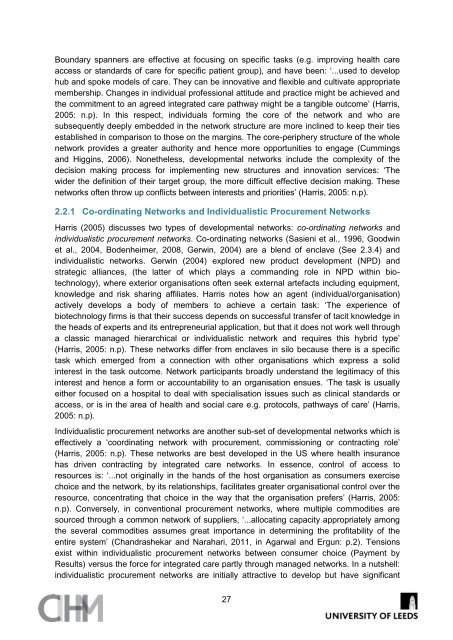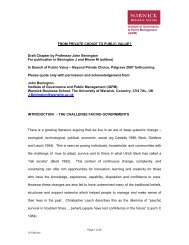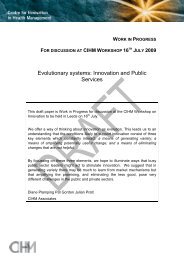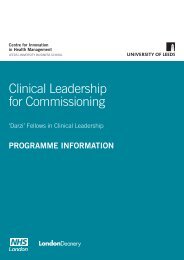Networks - a briefing paper for the Health Foundation - Centre for ...
Networks - a briefing paper for the Health Foundation - Centre for ...
Networks - a briefing paper for the Health Foundation - Centre for ...
- No tags were found...
Create successful ePaper yourself
Turn your PDF publications into a flip-book with our unique Google optimized e-Paper software.
Boundary spanners are effective at focusing on specific tasks (e.g. improving health careaccess or standards of care <strong>for</strong> specific patient group), and have been: ‘...used to develophub and spoke models of care. They can be innovative and flexible and cultivate appropriatemembership. Changes in individual professional attitude and practice might be achieved and<strong>the</strong> commitment to an agreed integrated care pathway might be a tangible outcome’ (Harris,2005: n.p). In this respect, individuals <strong>for</strong>ming <strong>the</strong> core of <strong>the</strong> network and who aresubsequently deeply embedded in <strong>the</strong> network structure are more inclined to keep <strong>the</strong>ir tiesestablished in comparison to those on <strong>the</strong> margins. The core-periphery structure of <strong>the</strong> wholenetwork provides a greater authority and hence more opportunities to engage (Cummingsand Higgins, 2006). None<strong>the</strong>less, developmental networks include <strong>the</strong> complexity of <strong>the</strong>decision making process <strong>for</strong> implementing new structures and innovation services: ‘Thewider <strong>the</strong> definition of <strong>the</strong>ir target group, <strong>the</strong> more difficult effective decision making. Thesenetworks often throw up conflicts between interests and priorities’ (Harris, 2005: n.p).2.2.1 Co-ordinating <strong>Networks</strong> and Individualistic Procurement <strong>Networks</strong>Harris (2005) discusses two types of developmental networks: co-ordinating networks andindividualistic procurement networks. Co-ordinating networks (Sasieni et al., 1996, Goodwinet al., 2004, Bodenheimer, 2008, Gerwin, 2004) are a blend of enclave (See 2.3.4) andindividualistic networks. Gerwin (2004) explored new product development (NPD) andstrategic alliances, (<strong>the</strong> latter of which plays a commanding role in NPD within biotechnology),where exterior organisations often seek external artefacts including equipment,knowledge and risk sharing affiliates. Harris notes how an agent (individual/organisation)actively develops a body of members to achieve a certain task: ‘The experience ofbiotechnology firms is that <strong>the</strong>ir success depends on successful transfer of tacit knowledge in<strong>the</strong> heads of experts and its entrepreneurial application, but that it does not work well througha classic managed hierarchical or individualistic network and requires this hybrid type’(Harris, 2005: n.p). These networks differ from enclaves in silo because <strong>the</strong>re is a specifictask which emerged from a connection with o<strong>the</strong>r organisations which express a solidinterest in <strong>the</strong> task outcome. Network participants broadly understand <strong>the</strong> legitimacy of thisinterest and hence a <strong>for</strong>m or accountability to an organisation ensues. ‘The task is usuallyei<strong>the</strong>r focused on a hospital to deal with specialisation issues such as clinical standards oraccess, or is in <strong>the</strong> area of health and social care e.g. protocols, pathways of care’ (Harris,2005: n.p).Individualistic procurement networks are ano<strong>the</strong>r sub-set of developmental networks which iseffectively a ‘coordinating network with procurement, commissioning or contracting role’(Harris, 2005: n.p). These networks are best developed in <strong>the</strong> US where health insurancehas driven contracting by integrated care networks. In essence, control of access toresources is: ‘...not originally in <strong>the</strong> hands of <strong>the</strong> host organisation as consumers exercisechoice and <strong>the</strong> network, by its relationships, facilitates greater organisational control over <strong>the</strong>resource, concentrating that choice in <strong>the</strong> way that <strong>the</strong> organisation prefers’ (Harris, 2005:n.p). Conversely, in conventional procurement networks, where multiple commodities aresourced through a common network of suppliers, ‘...allocating capacity appropriately among<strong>the</strong> several commodities assumes great importance in determining <strong>the</strong> profitability of <strong>the</strong>entire system’ (Chandrashekar and Narahari, 2011, in Agarwal and Ergun: p.2). Tensionsexist within individualistic procurement networks between consumer choice (Payment byResults) versus <strong>the</strong> <strong>for</strong>ce <strong>for</strong> integrated care partly through managed networks. In a nutshell:individualistic procurement networks are initially attractive to develop but have significant27
















